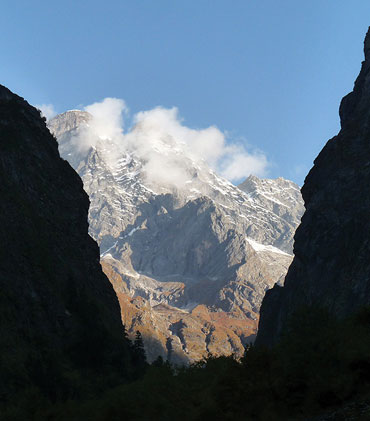
Fall brings an inexplicable beauty to India's Valley of Flowers, discovers Bijoy Venugopal.
When I arrived in the Valley of Flowers, Uttarakhand, I expected to experience the vistas I had gleaned from brochures and travelogues: Lush expanses of verdure embroidered with bright floral spangles. But the valley that greeted me was a picture of desiccation. The waist-high flowerbeds sported an autumnal burnish of ochre, gold and fawn as they braced for the inevitability of the Himalayan winter.
A hypnotic hush lingered, tempered only by the muted roar of distant waterfalls, feeble bird calls and the wheezy whisper of the wind among the drying stalks. I also felt an overwhelming sense of isolation ours was the only group traversing the white gravel path that snaked through the flowerbeds.
The last of the flower enthusiasts, who had braved the monsoon rains and the profusion of leeches, had departed weeks ago. The blossom-studded meadows that had charmed visitors from June to August were a distant memory. Gone were the much photographed Brahma Kamals (Rheum nobile) and cobra lilies. The violet primulas and buttery-yellow marsh marigolds had disappeared. The edelweiss had turned into ashen stars.
The celebrated Himalayan Blue Poppies, which bloomed during the monsoon and held an inexplicable fascination for Japanese flower-seekers, had turned into membranous cups rattling with seeds. Pale pink balsams with translucent stems were still in flower though some already bristled with seed pods. Only the geraniums, hemmed in by natural hedgerows of lilac asters and mustard inulas, thrust out their cheery pink and white blooms to greet the sun.
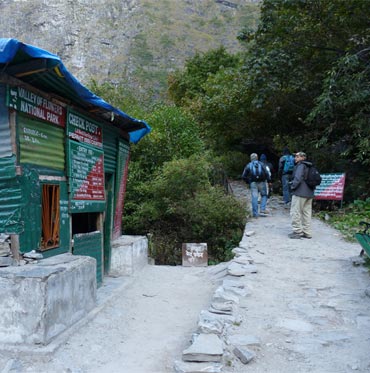
In the monsoon of 1931 the English mountaineer Frank Sydney Smythe and his botanist colleague R L Holdsworth, who were descending after their pioneering conquest of Mount Kamet, accidentally entered the Bhyundar Valley. Through veils of mist they spied expansive carpets of blue primula, irises, wild roses, violets and anemones. 'It was impossible to take a step without crushing a flower,' Smythe wrote in a subsequent memoir.
A consummate mountaineer, writer and photographer venerated by many of his contemporaries, Smythe had climbed extensively in the Himalayas as well as in the Alps and the Canadian Rockies. He had attempted Mount Everest three times twice with Hugh Ruttledge and once as a member of Eric Shipton and Bill Tilman's 1938 expedition. Smythe wrote more than 27 books and travelogues before he died at 49 of complications induced by malaria.
Returning to London after his unexpected discovery, Smythe devoted himself to gardening, a hobby inspired by his serendipitous descent into the Bhyundar Valley. But the 'Valley of Flowers', as he had christened it, haunted him constantly. In 1937, he returned to explore the region and wrote of it in his book, The Valley of Flowers (Hodder, London, 1938).
Near its end is a chapter titled 'Autumn in the Valley of Flowers', which served as my lodestone, as I wandered in Smythe's footsteps barely a week before the tourist season ended.
At 6 am, I made the day's first entry in the visitors' log of the Valley of Flowers National Park, 11,000 feet above sea level. The air was thin and chilly and our party of seven was breathless after a demanding climb through forests of Pindrow Fir, Indian Maple and dwarf rhododendron. Sheer cliff walls towered thousands of feet above us, framing the snowy hood of Nar Parvat (19,210 feet).

Distances can be tricky in the mountains and the walk to the valley was more exacting than we were prepared for. We descended a cobbled path darkened by conifers and crossed a bridge over the Pushpavati River, a thunderous torrent milky with glacial silt. Two miles of arduous, lung-inflating ascent saw us through to that excruciatingly beautiful place that had stolen Smythe's heart.
The Valley of Flowers sprawled before us like an Impressionist painting, glistening ruddy and russet in the young sunshine. Curlicues of glacial moraine framed the tawny edges of the meadows. The massifs of Rataban and Hathi Parvat dominated the background, their pale ice-peaks glinting.
Only a few weeks ago, the rich reds must have been suffused with pale green, and the month before that with mauve and crimson supplied by an eruption of wildflowers. Photographers who have documented the valley through the seasons attest that its colour composition changes every week.
'Sir, try this,' urged Rajneesh Singh Chauhan, offering me a fistful of dark grains and snapping me out of my reverie. After a half-day with our garrulous guide, our group had grown to trust him implicitly. We obediently nibbled and sniffed at things he held out to us, including berries, wild thyme and basil.
'Balsam seeds,' he said with a grin that could disarm a samurai. He popped a few in his mouth. Encouraged, I followed suit. They were delicious, with the rich, mulchy flavour of walnuts. 'Great topping for ice cream,' he remarked in Hindi, grinning until his slanted eyes disappeared in a maze of suntanned laugh lines.

Ice cream was the farthest thing from my mind. On the sunniest of days in the valley wind-chill can make your teeth chatter. Just a few minutes ago, I had basked in the glorious sunshine wearing a thin tee. As I fastened my shoelaces in the shadow of a humungous boulder the wind chafed at me, forcing me back into my fleece pullover. In my backpack I carried reinforcements: A scarf, mitts, a windcheater and a fleece-lined rain jacket.
The pony-tailed Chauhan's sunny demeanour made up for any inclement weather that we might encounter. Attired in a close-fitting sky-blue tee, olive cargoes and loud orange sunglasses, he sipped self-consciously from the water bladder in his backpack. Lithe, athletic and drunk on youth, our 27-year-old guide flaunted his agility to the two ladies in our group (it hardly mattered that they took no notice).
He clambered into tree hollows (which he claimed were previously occupied by bears) and wandered nonchalantly to cliff edges on the pretext of flushing wildlife. We took his insouciant machismo in stride partly because he was the best guide in the valley, and partly because we were flattered by his enthusiasm.
Chauhan was born 22 miles away in Joshimath, a congested hill town that takes its name from Jyotirmath, one of the four cardinal monasteries established by the Hindu revivalist saint Adi Sankaracharya in the 8th century. He trained at the Nehru Mountaineering Institute at Uttarkashi, 68 miles from his hometown, and set up shop about a decade ago in Ghangharia, two miles from the Valley of Flowers National Park. His store, HimTrek, is a tourist magnet stocked with boots, maps and mountaineering gear for serious trekkers, as well as baubles and trinkets for curious passersby.
Ghangharia (10,006 ft) is a seasonal habitation of eateries and lodges that operates during the tourist season from late June to early October. Most travellers are pilgrims to the Sikh shrine of Hemkunt Sahib, four miles away and 3,600 feet up the trail.
The gurdwara, established in 1937 by a Sikh soldier in the Indian Army, is now a modern structure that occupies one bank of a glacial lake ringed by snow-capped peaks. Lokpal, a name by which few know the lake, engenders the Hemganga (also known as Lakshman Ganga or the Bhyundar Ganga). This energetic mountain rivulet merges with the Alaknanda, a major headstream of the Ganga, 11 miles downstream at Govindghat.
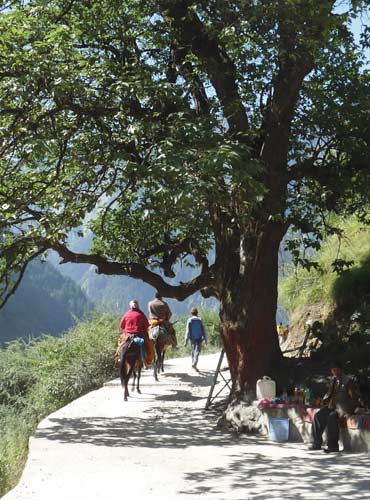
There is no provision for overnight halts at Hemkunt Sahib and pilgrims must descend by 2 pm to reach Ghangharia before sundown, which is earlier than usual in the valley given the elevation of the surrounding mountains. At the centre of the settlement (known to pilgrims as Govind Dham) is a gurdwara with a langar (community kitchen) that caters to pilgrims round the clock.
Amid exuberant shouts of Sat Nam Wahe Guru! parties of tired pilgrims stream into Ghangharia even as stalls hawking steaming tea, sweets and fritters rend the air with inviting aromas. The food is invariably vegetarian, but after chomping indelicately on wilted okra, we gathered that paneer was the only "vegetable" fit for consumption at the end of the season.
Our group was lodged at the best accommodation in Ghangharia the guesthouse maintained by the Garhwal Mandal Vikas Nigam, a government agency. Across Garhwal (one of two administrative divisions of the state of Uttarakhand; the other being Kumaon) the GMVN runs clean and affordable facilities including dorms, tents and log-huts. The guesthouse in Ghangharia is cozy and comfortable with clean restrooms and hot water on demand. Masseurs bearing racks of pungent-smelling mustard oil offer to soothe your weary feet.
Though there are a few solar panels on the rooftops, noisy generators power the village after sundown and for a few hours until daybreak. There is no cellular network and the satellite phones (expensive at Rs 20 a minute) are unreliable.
To reach Ghangharia we completed an exhausting eight-mile trek along a neatly paved bridle trail from the road head at Govindghat, the foaming confluence of the Hemganga and the Alaknanda rivers.
Crowded with pilgrims, mules and porters, and filthy as any tourist hub in the mountains, Govindghat is a cluster of teashops and tourist lodges surrounding a gurdwara. Being the last halt before the gateway to the sacred Vishnu shrine at Badrinath, 17 miles away, it also functions as an oversized parking lot.
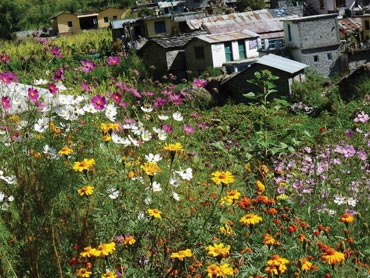
Crossing a suspension bridge across the jade-green Alaknanda we embarked on a trail that ascended to the picturesque village of Phulna, fringed by beds of marigold and cosmos.
Three pittoos (porters) walked ahead, slinging our bags effortlessly. The stamina of these Hindu migr s from neighbouring Nepal, who compete bitterly for business with the Muslim mule-drivers from the plains of Uttar Pradesh, is legendary. Along the way, we encountered pittoos carrying children and elderly pilgrims in khandis (large cane baskets).
Heavier human cargo was borne in palkis (palanquins) by four porters. Mule drivers positioned themselves tactfully at the toughest points of the trail, easily persuading exhausted pilgrims to complete the journey on muleback.
The trail from Phulna to the next settlement at Bhyundar village, four miles away, ran beside the rollicking Hemganga. Vendors called to us from shacks, selling cut fruits, freshly prepared lemon soda and a variety of bottled drinks and packaged snacks.
Pilgrims, consumed by devotion, routinely litter the path to salvation with the worldly things they have momentarily renounced, which unfortunately include plastic bottles and cellophane wrappers. Last year, the pilgrim season generated 44 tons of garbage.
Every half-mile of the trail is swept by sanitary workers employed by the Eco Development Committee Bhyundar, a non-governmental organization formed by the villagers with the support of the state forest department. They harvest the trash in gunnysacks and the gargantuan heaps contrast sorely with the emerald-green hills as they wait for mules to ferry them to Joshimath. The trash is then transported to New Delhi, 310 miles away, to be recycled.

It took us seven hours to walk from Govindghat to Ghangharia. The trail, which wound beside the roaring Hemganga, ascended 4,000 feet through forests of plane and oak to rhododendrons and conifers in the higher altitudes.
The forest trails echoed with birdsong. Flycatchers and thrushes flitted in the shrubbery while redstarts, dippers and forktails foraged beside the streams.
The trail meandered up and down, putting us through a punishing cardio routine that forced us to gasp for breath every few minutes. At every step the splendour of the scenery goaded us to continue.
From Ghangharia the trek to the valley was shorter, but no less demanding. The park, all of 55 square miles, is open from 6 am to 5 pm. Camping is prohibited and collecting specimens is illegal, though there are no checks of any kind. Notified as a National Park in 1982, the Valley of Flowers, along with the adjoining Nanda Devi Biosphere Reserve, was declared a UNESCO World Heritage Site in 1988.
The centre of the valley is occupied by a glacial corridor about three miles long and one-and-a-half miles wide. It is flanked by glaciers and presided by the snowy summits of Hathi Parvat, Nar Parvat and Rataban (all of which Frank Smythe had scaled in the 1930s).

The ruddy flowerbeds, at the end of their annual lifecycle, rustled in the breeze. We took a trail that led to the grave of Joan Margaret Legge, a botanist from Edinburgh who fell to her death in 1939 while collecting specimens. Local herdsmen buried her here. Her sister, who arrived a few months later, erected a headstone inscribed with the epitaph: 'I will lift up mine eyes unto the hills, from whence cometh my help.'
From the grave the cobbled path led to a grove of stunted birches, with beige-rose rolls of bark peeling off their trunks. Ancient manuscripts, Chauhan informed us, were inscribed on bhoj patra, Sanskrit for birch bark.
He also had disturbing news for us. The glaciers, he said, had receded by nearly a third of their length over the last decade that he had seen them. On field trips he often encountered flower poachers and on one occasion he had run into men with guns who were stalking musk deer.
"The forest department just doesn't have enough muscle to tackle them all," he said with a sad shake of his head.
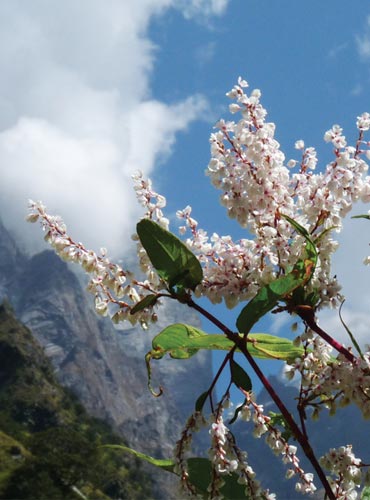
By 3 pm, clouds had collected overhead and the temperature had dropped by several degrees, warning us of an impending storm. Anxiously, Chauhan herded us back to Ghangharia. With the sun hidden, the valley looked ominous and threatening.
A forest ranger we met en route advised us to avoid the opposite bank of the Pushpavati, as a female bear with cubs had been sighted there. Himalayan black bears have a long history of conflict with humans and are notorious for raiding granaries and larders in winter or early spring when food becomes scarce in the forest.
Hunger, we empathized with the bears, was a big motivator. We returned to Ghangharia and fell greedily upon the hot pakoras and gulab jamuns at our favourite eatery. Thunder reverberated in the valley behind us and Nar Parvat disappeared in a halo of clouds. When they cleared an hour later we saw that the peak was draped in a fresh coat of snow.
Over dinner that evening Chauhan let us into a secret. "There is another valley where few people ever go and we might find flowers there if we are lucky," he said.
The next morning we left before sunup with Chauhan toward the leeward face of Hathi Parvat. We crossed the Hemganga at Bhyundar and took a trail through dense forests of blue pine, hazelnut and deodar.
Griffons and bearded vultures patrolled the sky as we skirted a tributary of the Hemganga studded with blinding white boulders. We entered a birch forest where the monsoon had departed reluctantly. Orange bracket fungi clung to the trees and pools of clear water sprung at our feet. Nutcrackers gaudy cousins of crows dropped half-eaten hazelnut cobs from the canopy. Gratefully, we scavenged for treats.
Climbing past a slender three-tiered waterfall, Chauhan led us to a valley where autumn had been late to arrive. Here, the plane trees had not shed their leaves and the rosy-white flowers stood tall and full.
"This," he announced, "is the other Valley of Flowers!"
Buntings bickered in the trees and clouds played tag with the peaks. There was not a human being around for miles. We ate our packed lunch and snoozed in the dappled shade of a flamboyant maple. In that delicious isolation, I felt as if I had re-entered the shelter of a childhood dream.
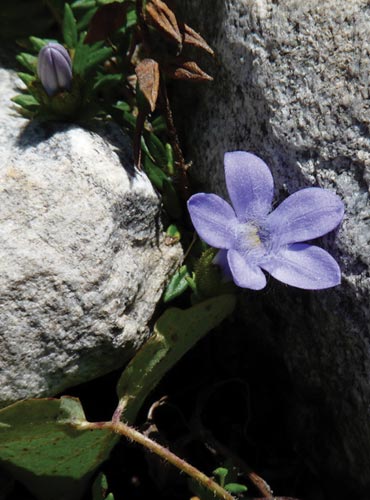
A distant murmur of thunder alerted us to the present and we hurried back to Ghangharia. That night I slept uneasily, dreaming of wilting flowerbeds and snowstorms in the valley. As September slipped behind us, the Valley of Flowers completed its gentle transformation into the Valley of Potpourri, rustling with phantom blossoms and perfumed with thyme and juniper.
On our sullen return journey to Govindghat, Bhyundar resembled a ghost town. The padlocked doors told us that the entire village had moved downhill to Phulna for the winter. With four days for the pilgrim season to end, the shacks that had served us parathas on our way uphill had also shut down.
Every year, with the first snowfall in late October, a hush descends over the valley, punctuated only by the frosty chatter of the Pushpavati. Griffons seek out carrion at lower altitudes and black bears tuck into tree hollows to hibernate. Even Rajneesh Singh Chauhan, ever at home in the mountains, locks up his store and returns to Joshimath to wait out the bitter winter.
Hail and sleet erode the bridle track to Hemkunt Sahib, allowing the Valley of Flowers to sleep undisturbed until the first pilgrims return in June to rebuild it.
Your guide to the Valley of Flowers National Park
Location: Chamoli district, Uttarakhand, India.
Nearest airport: Jolly Grant, Dehradun, 315 km/ 196 miles.
Nearest railhead: Hrishikesh, 285 km/ 177 miles.
Nearest roadhead: Govindghat, 16 km/ 10 miles.
Best time to go: June to August for flowers, August to early October for trekking.
Where to stay: GMVN guest house, Ghangharia, is the most reliable option. Book online at https://gmvnl.com/newgmvn/
What to do: Trek in the Valley of Flowers. Visit Hemkunt Sahib. Watch a film at Ghangharia's Eco Development Center, and buy books, postcards and video CDs.
What to pack: Comfortable and well-broken walking shoes, spare socks, cap/hat, thermals, rainwear and light to heavy woolens. Camera and binoculars. Energy bars, dry fruit and nuts for the trek. Food is not available inside the park.
What to remember: Purchase an entry permit from the forest check post at the park entrance; rates vary for Indian and foreign nationals. Private tour operators charge anywhere from Rs 10,000 (about $214) to Rs 20,000 ($429) for a five-day trek in the Valley of Flowers.